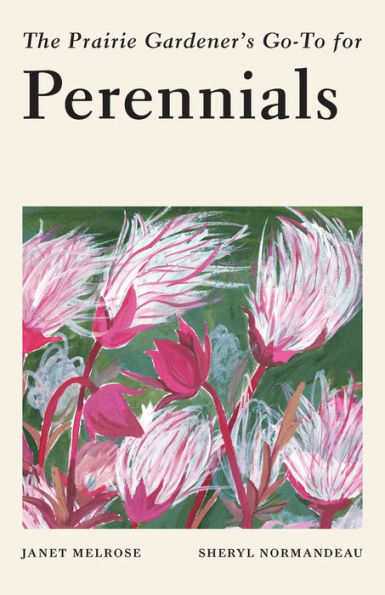
The Prairie Gardener's Go-To Guide for Perennials
160
The Prairie Gardener's Go-To Guide for Perennials
160Paperback
-
PICK UP IN STORECheck Availability at Nearby Stores
Available within 2 business hours
Related collections and offers
Overview
Perennials are those species whose stems and leaves die back to their crowns each fall, but whose roots remain alive throughout the non-growing months. They include showy flowers like peonies, poppies, lilies, clematis, and lupine, but also edibles like asparagus, fiddlehead ferns, sunchokes, and rhubarb.
In this guide prairie gardening experts Janet Melrose and Sheryl Normandeau answer questions like
- What are the best perennials for building biodiversity in my garden?
- What’s the difference between species, variety, cultivar, and nativar?
- What kinds of perennials can I grow in containers?
- When and how do I divide plants once they’re well established?
- How do I keep enthusiastic re-seeders from taking over?
- Which of my perennial babies need to be brought inside for the winter?
The pair dedicate a chapter to perennial vegetables and another to mitigating common pests and diseases. The final chapter is a perennial hall of fame, an extended list of recommended plantings for colour, native species, rock gardens, ground cover, fragrance, spring champions, and all-season displays. Janet and Sheryl give you the information you need to make your perennial garden as successful as you can while promoting biodiversity and creating a healthy habitat for pollinators and wildlife.

Product Details
| ISBN-13: | 9781771513920 |
|---|---|
| Publisher: | Heritage Group Distribution |
| Publication date: | 04/11/2023 |
| Series: | Guides for the Prairie Gardener , #8 |
| Pages: | 160 |
| Product dimensions: | 5.50(w) x 8.50(h) x (d) |
About the Author
Sheryl Normandeau is a life-long gardener, and holds a Prairie Horticulture Certificate and a Sustainable Urban Agriculture Certificate. She is a freelance writer specializing in gardening writing with hundreds of articles published. She is a regular contributor to The Gardener for Canadian Climates, The Prairie Garden Annual, and many more. She lives in Calgary.
Read an Excerpt
INTRODUCTION
Welcome to the world of perennials! What’s in a name? After all, William Shakespeare once wrote “That which we call a rose/By any other name would smell as sweet,” which is, of course, true. But humans love to pigeonhole things with names—for good or for bad—and in the plant world, names seem deliberately designed to bewilder, misdirect, and confuse. So, for the purposes of this book, we need to specify at the outset which types of plants we are dealing with in this very broad category of “perennials.”
By definition, the word “perennial” is something that is “lasting a very long time or happening repeatedly or all the time.” In botany, perennial generally means a plant that lives for three or more years. (Annuals are those plants that only live one year, completing their entire life cycle in one season. Biennials are those that do so within two seasons.) Perennials are usually categorized as woody or herbaceous. Woody refers to primarily to trees and shrubs, whose hard stems contain lignin. Herbaceous perennials have more pliable stems that contain cellulose. If we want to get even more technical (and we do!), herbaceous plants can be further divided into graminoids, those that are grass-like, and forbs, broadleaf flowering plants. (Just for fun, the category of forbs includes not just perennial plants, but annuals and biennials, too.) There are weeds that are perennial, as well as forage crops, herbs, bulbs, and many more. In this book, we are only going to include desirable (for our gardens) species whose aerial structures (stems and leaves) die back to their crowns each fall, but whose roots remain alive, though dormant, throughout the non-growing months. Oh, and naturally, they need to survive and thrive in our northern, highly variable, temperate climate. We are primarily focusing on gorgeous perennial flowers (and we’ll show you some photos containing some serious eye candy), but we’ll also cover a generous selection of perennial vegetables that can be grown on the prairies.We think that leaves us with lots to talk about, don’t you? And that’s exactly what we’re going to do! In The Prairie Gardener’s Go-To for Perennials, we’ll cover how to select perennials for your garden and get them growing—from stratifying and sowing seeds to transplanting and dividing. We’ll give you some tips about how best to water, fertilize, mulch, and deadhead them. We’ll help you diagnose and treat problems that may arise and discuss how to tackle challenging environmental conditions. Above all, we’ll give you the information you need to make your perennial garden as successful as you can while promoting biodiversity and creating a healthy habitat for pollinators and wildlife. Why not dig in?
—Sheryl Normandeau & Janet Melrose
Table of Contents
IntroductionPlant Selection
Pondering, Planning, and Planting Your Perennial Garden
The Care and Keeping of Your Perennial Plants
Perennial Vegetables
Pests and Diseases
Our Perennial Hall of Fame
Acknowledgements
Notes
Sources
Index
About the Authors
About the Series
